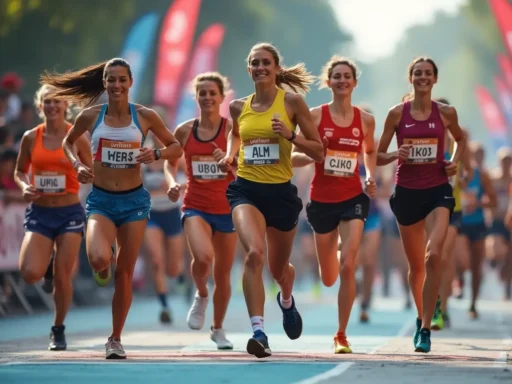If you run, you know about the 10K distance. It’s about 6.21 miles. Knowing how to change 10K to miles is key for planning and setting goals. It’s useful for both new and experienced runners.
A 10K is a common goal for many runners. Converting it to miles helps track progress and set targets. For example, aiming for a 10k in miles, which is about 6.2 miles, is a good training goal.

Changing 10K to miles might seem simple, but it’s important to get it right. Since 1 kilometer is about 0.62 miles, 10 kilometers is roughly 6.21 miles. This conversion is crucial for planning and setting goals, whether for a 10K or a longer race.
Knowing your 10K to miles conversion also lets you compare with others. It helps maintain your motivation to achieve your goals.
Table of Contents
Quick 10K to Miles Conversion
As a runner, you often need to switch between kilometers and miles, especially for 10K races. Converting 10K meters to miles is easy with a simple formula. To do this, use the formula: Miles = Kilometers x 0.621371. For instance, a 10K run is about 6.21 miles.
Converting 10K miles to km is the same but in reverse. This is handy for planning your training and keeping track of your progress. Many digital tools can also quickly convert distances, making it easier to plan and track your training.
The Basic Formula
The method for converting kilometers to miles is simple.. It works for any distance in kilometers. This formula helps convert 10K meters to miles and other distances too.
Common 10K Distance Equivalents
Here are some common 10K distance equivalents:
- 10K = 6.21 miles
- 5K = 3.1 miles
- Half Marathon = 13.1 miles
These equivalents are useful for planning your training and tracking your progress.
Digital Tools for Quick Conversion
Many digital tools can quickly convert 10K meters to miles and other distances. These tools are great for planning your training and tracking your progress. Online converters and mobile apps are some of the most popular tools.
Why Runners Need to Know Both Metric and Imperial Measurements
As a runner, it’s key to know both metric and imperial measurements. This helps in planning your training and setting goals. For example, knowing 10K is about 6.2 miles can boost your performance.
Tracking your progress in a system you’re comfortable with is vital. Most runners use miles for long races and kilometers for short ones. Over 90% of runners in international races use kilometers. Here are some common conversion ratios:
- 1.6 km = 1 mile
- 1 mile = 0.6 km
- 5 miles = 8 km
- 10 miles = 16 km

Knowing these conversions helps you stay on track and reach your goals. Whether training for a 5K, 10K, or marathon, being familiar with both systems is crucial. It lets you easily switch and communicate with other runners.
| Distance (km) | Distance (miles) |
|---|---|
| 5 km | 3.1 miles |
| 10 km | 6.2 miles |
| 50 km | approximately 31 miles |
Knowing both metric and imperial measurements can elevate your training. It helps you reach your goals, whether it’s a 10K or a marathon. So, get familiar with the 10K to miles conversions and track your progress in your preferred system.
Understanding the Math Behind 10K to Miles
To convert 10K to miles, you need to know the math. A 10K run is about 6.21 miles. This is key for runners to track their progress and plan their workouts.
For example, to convert 10K meters to miles, multiply 10 by 0.621371. This equals about 6.21 miles. This is important for runners in international races, where distances are in kilometers.
Step-by-Step Conversion Process
The conversion is simple. You can use a calculator or a chart to change 10K to miles. Here’s how:
- Multiply the distance in kilometers by 0.621371.
- Round the result to the nearest hundredth or thousandth, depending on your desired level of precision.
- Use the converted distance to plan your training sessions or track your progress.

Rounding and Precision in Race Distances
Rounding and precision matter a lot in race distances. A small mistake can affect your performance over time. For instance, training for a 10K race means running the exact distance to avoid undertraining or overtraining.
| Distance in Kilometers | Distance in Miles |
|---|---|
| 10K | 6.21 miles |
| 5K | 3.1 miles |
| 15K | 9.3 miles |
Knowing the math behind 10K to miles conversion helps improve your training. It’s vital for tracking progress and planning workouts, whether you’re new or experienced.
The History of the 10K Distance in Running
The 10K distance has a rich history in running, dating back to the ancient Olympic Games. It gives us insight into the sport and the challenges runners have faced. To convert 10K to miles, it’s about 6.21 miles.
Notable 10K events include the Peachtree Road Race in Atlanta, with over 55,000 participants in 2011. The Vancouver Sun Run and Bolder Boulder also draw close to 50,000 participants each year. The fastest male 10K runners are all from East Africa, with the top ten as of January 2020. For women, nine out of the top ten fastest are Kenyan.
The history of the 10K distance is interesting. The first official world records were set in 2003. Before then, the fastest times were called “world bests” but not official records. The current men’s world record is 26:24 minutes, set by Rhonex Kipruto in 2020, which is about 6.21 miles.
Here are some key facts about the 10K distance:
- The current women’s world record for the 10K road distance is 28:46 minutes, set by Agnes Ngetich in 2024.
- The Běchovice–Prague race has been held since 1897, making it one of the longest-running 10K events.
- Major sponsorships for 10K events typically include medical organizations, fitness groups, drinks manufacturers, and sportswear companies.
Training Plans: Converting Weekly Mileage to Kilometers
Creating a training plan means knowing how to change weekly mileage to kilometers. This is key for runners who track progress in both systems. For instance, if you’re training for a 10k, you can convert it to miles. 10k is about 6.2 miles. So, 20 miles a week is roughly 32 kilometers.
To make a good training schedule, follow these tips:
- Maximum recommended runs for a 10k training plan: 4 runs per week
- Elite runners might run over 100 miles a week. Amateur runners should aim for 2 to 4 runs a week, lasting 30 to 75 minutes each.
- Gradually increase your mileage. Aim for no more than 8% to 10% more each week.
Knowing how to convert 10k miles to km and vice versa helps in making a fitting training plan. Always listen to your body and tweak your plan to avoid injuries. This way, you can reach your running goals successfully.
Popular 10K Races Around the United States
Are you training for a 10K? That’s 6.2 miles. You might want to join a popular 10K race in the U.S. These events are all over the country. They’re perfect for runners of all levels, offering a chance to test your limits and enjoy the company of fellow runners.
Some notable 10K races include:
- The Cap10K in Austin, TX, which is one of the largest 10K races in the country
- The Boston 10K, a new race that showcases local landmarks
- The King’s Runner 10K in Honolulu, HI, which features a unique urban course
- The Peachtree Road Race 10K in Atlanta, GA, known for its festive atmosphere
These races are a great way to feel the excitement of running a 10K. You’ll also get to see beautiful views and enjoy the buzz of a big event. Whether you’re an experienced runner or just starting, there’s a 10K race for you. Training for a 10K can help you push your limits and reach your fitness goals.
| Race Name | Location | Date |
|---|---|---|
| Cap10K | Austin, TX | April 6, 2025 |
| Boston 10K | Boston, MA | June 2025 |
| King’s Runner 10K | Honolulu, HI | March 2, 2025 |
Race Pace Calculator: Miles vs. Kilometers
When training for a race, setting a realistic pace goal is key. A race pace calculator helps you set targets and track your progress. To use it well, knowing how to convert miles to kilometers is crucial.
For instance, if you’re training for a 10k race, you’ll need to convert 10k meters to miles and vice versa. This helps in setting the right pace.
A common distance conversion table can guide you. It shows the equivalent distances in miles and kilometers. Here’s a table with some common distances:
| Distance in Kilometers | Distance in Miles |
|---|---|
| 5K | 3.1 miles |
| 10K | 6.2 miles |
| Half Marathon | 13.1 miles |
Knowing how to convert miles to kilometers helps you set pace goals. Whether it’s for a 10k race or a longer distance, a race pace calculator is your ally.
Benefits of Running a 10K Distance
Running 10K, or 6.2 miles, is great for everyone. It boosts your heart health and stamina. It’s a good challenge that’s not too hard, making you feel proud and motivated.
Some key benefits of running 10K include:
- Improved cardiovascular fitness, contributing to a better quality of life and health
- Increased muscle strength and endurance
- Enhanced bone density, reducing the risk of osteoporosis and fractures
- Weight loss and improved body composition, leading to enhanced overall fitness
- Reduced anxiety and improved mood, due to the release of endorphins during exercise
Running 10K can burn 700-900 calories, based on your weight and speed. It’s a safe way to start running, avoiding injuries and burnout. Finishing a 10K race in 40-60 minutes is a great achievement.
Training for a 10K improves your health a lot. You’ll see lower blood pressure, heart rate, and cholesterol. It’s a good mix between short and long races. Running 10K can greatly improve your physical and mental health, no matter your skill level.
Comparing Different Race Distances: 5K vs. 10K vs. Half Marathon
As you start or continue your running journey, it’s key to know the differences between race distances. Whether you’re new or experienced, understanding each distance’s challenges helps you pick the right one. For example, knowing how to convert 10k in to miles or 10k meters to miles is vital for planning your training and race strategy.
For beginners, starting with a 5K (3.1 miles) is common. Then, they move to longer distances like the 10K (6.2 miles) or half marathon (13.1 miles). The training time needed for each distance varies. The 5K requires the least time, while the half marathon needs a lot more, about 16 to 20 weeks of training.
Distance Progression for Beginners
- Start with a 5K (3.1 miles) to build endurance and confidence
- Gradually progress to a 10K (6.2 miles) to increase distance and speed
- Finally, move to a half marathon (13.1 miles) to challenge yourself and achieve a significant milestone
When comparing these distances, it’s important to look at average finishing times. For example, a casual runner might finish a 10K in 40 to 60 minutes. An elite runner can do it in under 30 minutes. For a half marathon, most runners take 1.5 to 2 hours, while elites finish in under 60 minutes. By understanding these times and converting 10k in to miles or 10k meters to miles, you can set realistic goals and plan your training effectively.
Nutrition and Hydration for 6.2 Miles
Getting ready for a 10K race means focusing on the right food and water. 20% of runners underfuel before a race, which can hurt their performance. Eat a balanced diet with carbs, protein, and fats.
Having a good meal plan is key for a 10K. You should eat 6–8 grams of carbs for every kg of your body weight. For a 75 kg runner, that’s 450 to 600 grams of carbs. Also, drink at least eight 8-ounce glasses of water before the race.
Here are some important nutrition tips:
- Eat complex carbs like whole grains, fruits, and veggies
- Include lean proteins like chicken, fish, or beans for muscle support
- Stay away from high-fat, high-fiber foods to avoid stomach issues
Eat a pre-race meal 2–3 hours before starting. Choose a meal with 50% veggies, 25% protein, and 25% starch. Drink at least 2 cups of fluid in the 2 hours before the race. These tips will help you get ready for the 6.2 miles of a 10K race.
| Nutrient | Recommended Intake |
|---|---|
| Carbohydrates | 6-8 grams/kg body weight |
| Protein | 10-20 grams post-run |
| Water | At least 8 cups (64 oz) per day |
GPS Tracking and Distance Accuracy
When training for a 10k run, knowing your GPS device’s accuracy is key. With many people using fitness trackers, it’s important to calibrate them right. A small error in distance can affect your training a lot.
Studies show GPS devices are good at tracking distance. But, different devices might show different results. For example, Strava might say a run is 3.63 miles, while your watch says 3.52 miles. This difference comes from how well the device is set up and the terrain.
Device Calibration Tips
To get accurate distance readings, calibrate your device often. Run a known distance, like a 10k course, to adjust your device. Also, know how your device works, like how terrain and satellite signals affect it.
Understanding Measurement Variations
When tracking your runs, remember that distance readings can vary. Recreational GPS units might be off by up to 10%. But, courses surveyed professionally give more precise readings. Knowing these differences helps you plan your training better.
By following these tips, you can get more accurate distance readings. This is crucial whether you’re training for a 10k run or just tracking your miles. Accurate tracking helps you reach your goals.
International Racing: Understanding Global Distance Standards
International racing requires knowing global distance standards. The 10K to miles conversion is key, as most races use the metric system. Athletes must understand the different measurements used worldwide.
In big events like the Olympics, knowing the 10K to miles conversion is crucial. A 10,000m race is 6.2 miles and has 25 laps on a 400m track. Athletes must pace well, aiming for a lap time that lets them finish strong.
Here are some important facts about international racing and distance standards:
- The 10,000m race is a long-distance event that requires proper pacing and training.
- Athletes should consume a protein-rich, balanced diet to prepare for the race.
- The course measurement certificate is valid for five years, and the course must be re-measured after that period.
Knowing the 10K to miles conversion and global standards helps you tackle different races. It keeps you competitive and helps you reach your goals, no matter the distance or location.
| Distance | Metric | Imperial |
|---|---|---|
| 10,000m | 10,000 meters | 6.2 miles |
| 5,000m | 5,000 meters | 3.1 miles |
Common Training Mistakes When Converting 10K to Miles
Many runners face challenges when they switch from 10K to miles. One big mistake is overtraining, especially when changing mileage a lot. This can happen when trying to switch from 10K miles to km or the other way around without thinking about the impact on training.
Another mistake is not getting the training volume right. For instance, if you’re used to running 10K meters to miles, you might need to adjust your training plan. It’s wise to start with small increases in mileage to avoid injuries.
Pace Calculation Errors
When converting 10K to miles, pace calculation errors can occur. This might happen if you don’t understand the conversion process well or ignore your own fitness level and running experience. To avoid this, use a reliable pace calculator and think about terrain, weather, and recovery time.
Training Volume Miscalculations
Getting the training volume wrong can affect your performance and increase injury risk. For example, if you’re training for a 10K race and switch your mileage from kilometers to miles, you might need to adjust your training volume. It’s best to keep your weekly mileage steady and avoid sudden changes.
| Distance | 10K Meters to Miles | 10K Miles to Km |
|---|---|---|
| 5K | 3.1 miles | 5 kilometers |
| 10K | 6.2 miles | 10 kilometers |
| Half Marathon | 13.1 miles | 21.1 kilometers |
Knowing these common training mistakes can help you avoid them and stay on track. Always use a reliable pace calculator and consider your own fitness level and running experience when converting 10K to miles or 10K miles to km.
Conclusion
Starting your running journey? Learning to convert 10K to miles is key. It boosts your performance and helps reach your goals. It’s useful for both new and seasoned runners.
This skill lets you plan your workouts, set pace goals, and track your progress. You’ll feel more confident in your training.
Knowing how to convert 10K to miles helps you understand your training and race times. It’s especially helpful in international races. You can share your achievements with runners worldwide.
With practice, you’ll improve your running and adapt to new challenges. This knowledge is crucial for your growth as an athlete. So, keep learning and applying this skill. Your running success is on the line.




